
Biomedical Human Kinetics
Scope & Guideline
Empowering Health Through Evidence-Based Research
Introduction
Aims and Scopes
- Human Movement Analysis:
The journal focuses on studies that analyze human movement patterns, including gait, balance, and athletic performance, utilizing various methodologies such as biomechanical assessments and motion analysis. - Physiological Responses to Exercise:
Research on how different forms of exercise affect physiological parameters, including cardiovascular fitness, metabolic responses, and muscle recovery, is a core area of interest. - Rehabilitation and Injury Prevention:
A significant emphasis is placed on studies exploring rehabilitation techniques, injury prevention strategies, and the effects of therapeutic interventions on recovery and performance. - Psychological Factors in Sports and Exercise:
The journal includes research on the psychological aspects of physical activity, such as motivation, mental toughness, and the impact of exercise on mental health. - Health Promotion and Fitness Education:
There is a consistent focus on health-related fitness education, the promotion of physical activity, and the assessment of fitness knowledge among various populations. - Special Populations and Conditions:
Research addressing the unique needs of special populations, including the elderly, disabled individuals, and those with chronic health conditions, is a prominent feature.
Trending and Emerging
- Holistic Health Interventions:
An increasing number of studies explore holistic approaches to health, including the integration of mental health, nutrition, and physical activity, highlighting the interconnectedness of these factors. - Technology in Movement Analysis:
The use of advanced technologies, such as wearable devices and motion capture systems, for assessing and enhancing movement quality is becoming more prevalent, indicating a trend towards data-driven insights in human kinetics. - Functional Training and Rehabilitation:
Research focusing on functional training methodologies and their application in rehabilitation settings is on the rise, emphasizing the importance of real-world applicability in both athletic and clinical populations. - Mindfulness and Mental Skills in Sport:
There is a growing body of work examining the role of mindfulness and mental skills training in enhancing athletic performance and coping with the psychological demands of competition. - Environmental and Contextual Factors:
Studies investigating how environmental conditions and contextual factors affect physical performance and exercise adherence are gaining traction, reflecting a more comprehensive understanding of human kinetics.
Declining or Waning
- Traditional Sports Performance Metrics:
There has been a noticeable decrease in the publication of studies focused solely on traditional performance metrics, such as strength and speed, as the field shifts towards more integrative approaches that consider psychological and physiological factors. - Static Balance Assessments:
Research specifically centered on static balance assessments has diminished, possibly due to a growing preference for dynamic balance studies that better reflect real-world scenarios and athletic performance. - Single-Discipline Training Studies:
The focus on single-discipline training studies is waning as interdisciplinary approaches that combine various training modalities gain traction, reflecting a more holistic view of athletic training. - Invasive Measurement Techniques:
The use of invasive measurement techniques, such as blood draws for metabolic assessments, has decreased in favor of non-invasive methods, aligning with ethical considerations and participant comfort. - Age and Gender Specific Studies:
While still important, there has been a decline in studies exclusively focused on age and gender differences in performance, as the field moves towards more inclusive research that examines broader population dynamics.
Similar Journals
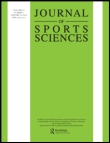
JOURNAL OF SPORTS SCIENCES
Empowering professionals through cutting-edge sports research.The JOURNAL OF SPORTS SCIENCES, published by TAYLOR & FRANCIS LTD, serves as a premier platform for disseminating influential research in the fields of sports science, orthopedics, and rehabilitation. With an impressive ISSN of 0264-0414 and E-ISSN of 1466-447X, this UK-based journal has established a significant presence in the academic community since its inception in 1983, continuing to thrive through 2024. It holds a coveted Q1 ranking across multiple disciplines including Orthopedics and Sports Medicine, and ranks 30th in Physical Therapy, showcasing its relevance and impact in the health professions sector. Although the journal does not currently offer open access, it remains a critical resource for researchers, professionals, and students dedicated to advancing knowledge and practice in sports sciences. The journal's commitment to publishing high-quality, peer-reviewed articles ensures that it remains at the forefront of innovation and discovery in sports-related health and rehabilitation.
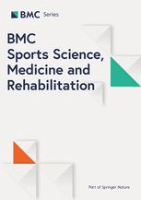
BMC Sports Science Medicine and Rehabilitation
Pioneering open-access research in sports science and rehabilitation.BMC Sports Science Medicine and Rehabilitation is a leading open-access journal published by BMC, based in the United Kingdom, dedicated to the dissemination of high-quality research in the fields of sports science, medicine, and rehabilitation. Established in 2013, the journal has quickly gained a prominent position, achieving Q2 rankings in major categories such as Orthopedics and Sports Medicine, Physical Therapy, Sports Therapy and Rehabilitation, and Rehabilitation as of 2023. With a Scopus ranking placing it in the 66th percentile for Rehabilitation and the 62nd percentile for Physical Therapy, BMC Sports Science Medicine and Rehabilitation serves as a vital resource for researchers, practitioners, and students alike. Its open-access format ensures that groundbreaking research is freely available, promoting knowledge exchange and fostering advancements in therapeutic practices and sports science innovations. Authors and readers are encouraged to engage with the journal's broad scope, spanning from evidence-based interventions to innovative rehabilitation strategies, all aimed at enhancing human performance and well-being.
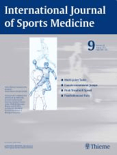
INTERNATIONAL JOURNAL OF SPORTS MEDICINE
Pioneering Research for Athletic ExcellenceINTERNATIONAL JOURNAL OF SPORTS MEDICINE, published by GEORG THIEME VERLAG KG, is a leading peer-reviewed journal dedicated to advancing the knowledge and practice in the fields of orthopedics, sports medicine, and rehabilitation. With a robust history since its inception in 1980 and an impressive breadth of converged research addressing contemporary issues until 2024, the journal stands as a vital resource for researchers, practitioners, and students alike. Notably, it holds an advantageous Q2 designation in Orthopedics and Sports Medicine and Physical Therapy, Sports Therapy and Rehabilitation categories, emphasizing its significant impact within these domains. Rankings from Scopus highlight its substantial influence, with a commendable presence in percentile rankings (80th and 76th) for its respective categories. Although not an open-access journal, the valuable insights and cutting-edge research articles published herein contribute significantly to the evolution of sports medicine practices. The INTERNATIONAL JOURNAL OF SPORTS MEDICINE is essential for those aiming to stay at the forefront of this dynamic field.

European Journal of Human Movement
Exploring Innovations in Human MotionThe European Journal of Human Movement, published by the University of Extremadura, Faculty of Sports Sciences in Spain, stands as a vital resource within the realms of Health, Physical Therapy, and Social Sciences. With its consistent commitment to Open Access since 2014, the journal facilitates the dissemination of high-quality research, fostering innovation and collaboration among scholars, practitioners, and students alike. The journal has carved out a niche in its categories, being ranked in the Q3 quartile across several fields, including Health (social science) and Physical Therapy, Sports Therapy, and Rehabilitation. With an ongoing publication timeline extending from 2019 to 2024, it aims to highlight contemporary issues, emerging trends, and groundbreaking studies within human movement sciences. Additionally, with its presence in the Scopus ranking and a determination to elevate research standards, the journal remains an essential platform for sharing knowledge and advancing professional practice in a rapidly evolving landscape.

Frontiers in Sports and Active Living
Fostering interdisciplinary dialogue for active living advancements.Frontiers in Sports and Active Living, published by FRONTIERS MEDIA SA, is a pioneering open-access journal that has been at the forefront of research since its establishment in 2019. Operating from its prestigious base in Lausanne, Switzerland, this journal stands out with its commitment to disseminating cutting-edge research across various disciplines, including Anthropology, Orthopedics and Sports Medicine, and Public Health, among others. With consistently high rankings—achieving Q1 status in its category for Anthropology and Q2 in several related fields—it serves as an essential resource for scholars and practitioners alike. The journal's open-access model not only enhances visibility but also fosters collaboration and innovation in the domains of physical therapy, sports therapy, and rehabilitation. As it continues to evolve, Frontiers in Sports and Active Living strives to provide a vibrant platform for academic excellence, encouraging interdisciplinary dialogue that can significantly advance our understanding of active living and its impacts on health and society.
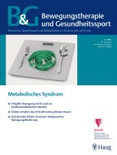
Bewegungstherapie und Gesundheitssport
Unlocking the Potential of Physical Activity for HealthBewegungstherapie und Gesundheitssport, published by GEORG THIEME VERLAG KG, is a distinguished journal primarily focused on the fields of movement therapy, health sports, and rehabilitation sciences. With a commitment to fostering knowledge dissemination and innovation in promoting physical health and well-being, this journal serves as a vital resource for researchers, health professionals, and students interested in the intersection of exercise and therapy. While currently not offering an open access model, it maintains a robust impact on academic discourse, supported by rigorous peer-reviewed research that spans diverse methodologies and interdisciplinary approaches. The journal invites high-quality contributions that explore the efficacy of movement therapies, the impact of physical activity on health disorders, and emerging trends in health promotion strategies, thereby enhancing the understanding of physical well-being's role in society.
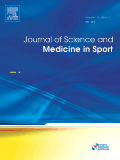
JOURNAL OF SCIENCE AND MEDICINE IN SPORT
Exploring innovative methodologies for athletic health.JOURNAL OF SCIENCE AND MEDICINE IN SPORT, published by Elsevier Science Ltd, is a premier academic journal based in the Netherlands that serves as a vital platform for disseminating cutting-edge research in the fields of sports medicine, orthopedics, and physical therapy. With an impressive Q1 categorization in Orthopedics and Sports Medicine, Physical Therapy, and Sports Science, this journal is recognized for its high-impact contributions and currently holds a significant rank in Scopus, positioned at #17 in Physical Therapy and #25 in Orthopedics. Spanning from 1998 to 2024, it provides scholars with rigorous peer-reviewed articles aimed at enhancing knowledge, practice, and research in sports and medicine. Although it does not offer open access, the journal remains essential for professionals, researchers, and students looking to stay ahead in these dynamic disciplines. By focusing on evidence-based practices and innovative methodologies, the JOURNAL OF SCIENCE AND MEDICINE IN SPORT continues to play a pivotal role in advancing the scientific understanding of health and performance in sports.

International Journal of Sports Physical Therapy
Elevating patient care in sports physical therapy.Welcome to the International Journal of Sports Physical Therapy, a premier platform dedicated to advancing the field of sports therapy and rehabilitation. Published by the NORTH AMER SPORTS MEDICINE INST-NASMI, this open access journal has been vital in disseminating state-of-the-art research since its inception in 2011. With an ISSN of 2159-2896, it boasts a commendable standing within the academic community, achieving a Q2 ranking in 2023 across multiple categories, including Orthopedics and Sports Medicine, Physical Therapy, and Rehabilitation. Spanning diverse topics relevant to sports physical therapy, this journal serves as an invaluable resource for researchers, clinicians, and students alike, promoting best practices and innovative techniques in the field. By maintaining a commitment to high-quality peer-reviewed content, it not only contributes significantly to the existing body of knowledge but also fosters collaboration among professionals seeking to enhance patient care and rehabilitation outcomes.
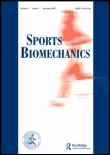
Sports Biomechanics
Pioneering Research in Orthopedics and Sports TherapySports Biomechanics, a prominent journal published by ROUTLEDGE JOURNALS, TAYLOR & FRANCIS LTD, serves as a critical platform for researchers and professionals in the fields of orthopedics, sports medicine, and rehabilitation. With an ISSN of 1476-3141 and an E-ISSN of 1752-6116, this journal has been influential since its inception in 2002 and is set to continue making an impact until 2024. The journal holds respectable positions within various quartiles, specifically Q2 in Orthopedics and Sports Medicine, Q2 in Physical Therapy, Sports Therapy and Rehabilitation, and Q3 in Sports Science as of 2023. Its Scopus rankings further underscore its significance in the academic community, ranking 35th in Physical Therapy and 55th in Orthopedics. Although not an Open Access journal, Sports Biomechanics provides a robust forum for disseminating cutting-edge research that enhances the understanding of human movement, injury prevention, and the rehabilitation process, making it an invaluable resource for students, academics, and practitioners dedicated to advancing the science of sports biomechanics.

Kinesiology
Exploring the frontiers of movement and rehabilitation.Kinesiology is a leading academic journal published by UNIV ZAGREB, FAC KINESIOLOGY in Croatia, dedicated to advancing the fields of physical therapy, sports therapy, rehabilitation, and sports science. With an ISSN of 1331-1441 and E-ISSN of 1848-638X, this open-access journal, established in 2004, provides a platform for innovative research and practical applications, allowing wider accessibility and dissemination of knowledge. The journal holds a strong position in the academic community, boasting a 2023 categorization of Q2 in Physical Therapy, Sports Therapy and Rehabilitation, and Q3 in Sports Science, reflecting its significant impact and relevance within these fields. Researchers, professionals, and students benefit from its rigorous peer-reviewed articles that address contemporary challenges and breakthroughs. The dynamic scope of the journal spans from 2008 to 2024, ensuring the incorporation of cutting-edge studies while fostering a vibrant exchange of ideas amongst scholars. As an invaluable resource, Kinesiology connects a diverse audience, promoting the growth of knowledge in health professions and enhancing evidence-based practices in physical therapy and rehabilitation.